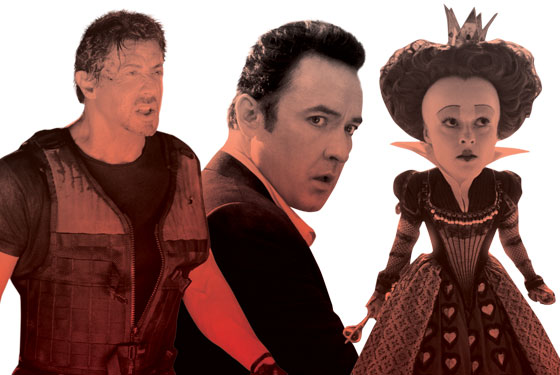
As Hollywood grows ever more reliant on foreign box offices, no prize is more tantalizing than China, where grosses are up more than 900 percent since 2003. But it’s a tricky market to crack. Only around twenty outside films are allowed in each year (this summer almost every screen in the country was taken over for seven weeks by an epic about the Chinese Communist Party), and a blockbuster in the U.S. isn’t always a blockbuster in China (and vice versa).
WHAT MAKES FOR A CHINESE HIT
Why some American films go over better across the Pacific than they did at home, and some essentially sink en route.
THE EXPENDABLES
All-time box-office rank, China: 8
All-time box-office rank, U.S.: 448
2012
All-time box-office rank, China: 2
All-time box-office rank, U.S.: 174
ALICE IN WONDERLAND
All-time box-office rank, China: 7
All-time box-office rank, U.S.: 20
KEY INGREDIENT NO. 1: FAMILIAR FACES
Shanghai University’s Shaoyi Sun calls “pre-familiarity” a big factor; most Chinese learned Lewis Carroll’s Alice tale in school, while stars like The Expendables’ Sly Stallone are even more crucial to hits in China than in America.
KEY INGREDIENT NO. 2: BIG-SCREEN WORTHINESS
Says Southern Cal prof Stanley Rosen: “Seeing a blockbuster on home video shows no status. Even people who went to see Avatar in 2-D were laughed at.” 2012 was all spectacle (well, and it featured noble Chinese soldiers).
TWO TELLING FLOPS
SHERLOCK HOLMES
Avatar’s Chinese gross was a third of what it made domestically despite the U.S.’s relative affluence. Sherlock’s Chinese gross was one eighteenth of what it made here; its assumption of audience familiarity with another time and place hurt it. In China, generic, universally comprehensible plots work best.
ALVIN AND THE CHIPMUNKS: THE SQUEAKQUEL
Alvin made more than $200 million here but only $1 million or so in China. Unfamiliarity was a problem—Alvin has been around since the fifties but never made inroads in China—while ho-hum animation didn’t give viewers a reason to take it in on the big screen. (The visually lush Shrek did much better.)
IMAX INDEX
China, where special effects rule, already has more Imax screens than any nation but the United States.
36: China
27: Canada
18: Japan
EST. PERCENTAGE OF SCREENS THAT USE DIGITAL PROJECTORS:
Digitally projected movies don’t look better than those shown on film. Rather, the spread of digital projection in China is a symptom of the fact that, in China, seeing a film at an old theater is déclassé, not boho-hip—and the sleek new theaters that audiences prefer use digital because it’s cheaper.
U.S.: 20%
China: 45%
Have good intel? Send tips to intel@nymag.com.